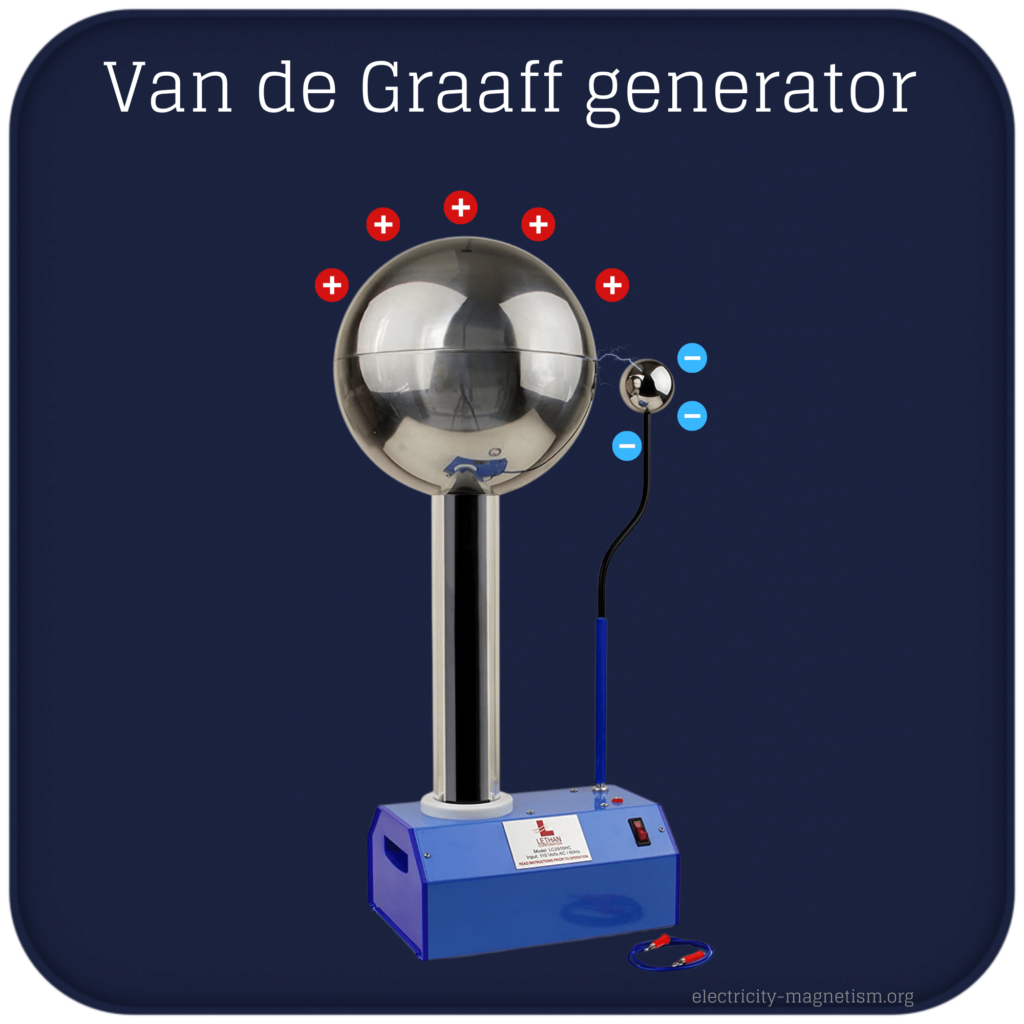30-second summary
Van de Graaff generator
A Van de Graaff generator (VDG) is an electrostatic device capable of producing very high voltages while maintaining a smaller, constant current. The first Van de Graaff generator was built in 1929 by Robert J. Van de Graaff, the American physicist, and inventor.
It uses a moving belt to accumulate electric charge on a hollow metal globe on the top of an insulated column, creating very high electric potentials.
The potential difference achieved by modern Van de Graaff generators can be as much as 5 megavolts.
Aside from its use in educating physics students about the properties of electrostatics, the Van de Graaff generator has been most frequently implemented as a power supply for particle accelerators.

Static Electricity
Static electricity is an informal term for phenomena caused by the accumulation of electric charge on the surface of various bodies and objects and their exchange in contact with each other.
Most of the static electricity we encounter every day is caused by the triboelectric effect. The triboelectric effect is a type of contact electrification in which certain materials become electrically charged after they come into contact with one another and then separated.
The friction of the two materials greatly increases the effect due to the frequent contact and separation of these materials. On dry days, static electricity is much more noticeable since the air contains fewer water molecules to allow leakage.
Note that a very high voltage is required to generate every 1mm of an electric arc. Air is a very bad conductor of electricity and has high dielectric strength. The dielectric strength of air is nearly 3000V/mm. Under severe conditions, up to 15 000 Volts have been recorded. It is quite common to experience 5 000V. In fact, many people do not feel a shock from a static electricity discharge of less than about 2 000-4 000V. The main reason that shock caused by static electricity does not hurt anybody is its very low amperage.
Van de Graaff generator
A Van de Graaff generator (VDG) is an electrostatic device capable of producing very high voltages while maintaining a smaller, constant current. The first Van de Graaff generator was built in 1929 by Robert J. Van de Graaff, the American physicist, and inventor. It uses a moving belt to accumulate electric charge on a hollow metal globe on the top of an insulated column, creating very high electric potentials.
A simple Van de Graaff generator consists of a belt of rubber (or a similar flexible dielectric material) moving over two rollers of differing material, one of which is surrounded by a hollow metal sphere. A comb-shaped metal electrode with sharp points is positioned near each roller. The upper comb is connected to the sphere and the lower one to the ground. When a motor is used to drive the belt, the triboelectric effect causes the transfer of electrons from the dissimilar materials of the belt and the two rollers. As can be seen in the figure, the rubber of the belt will become negatively charged while the acrylic glass of the upper roller will become positively charged. The belt carries away a negative charge on its inner surface while the upper roller accumulates a positive charge.
The potential difference achieved by modern Van de Graaff generators can be as much as 5 megavolts. The Van de Graaff generator was originally developed as a particle accelerator for physics research, as its high potential can be used to accelerate subatomic particles to great speeds in an evacuated tube. Aside from its use in educating physics students about the properties of electrostatics, the Van de Graaff generator has been most frequently implemented as a power supply for particle accelerators. Van de Graaff-powered x-ray machines have been used for imaging and medical treatment.
Frequently asked questions
Most of the static electricity we encounter every day is caused by the triboelectric effect. This can easily be produced by rubbing two dissimilar materials together, such as rubbing amber with fur or glass with silk. The friction of the two dissimilar materials greatly increases the effect due to the frequent contact and separation of these materials.
It is quite common to experience 5 000V. In fact, many people do not feel a shock from a static electricity discharge of less than about 2 000-4 000V. The main reason that shock caused by static electricity does not hurt anybody is its very low amperage.
There are different types of electrostatic generators (ESG’s); they can be friction or induction generators.
Wimshurst machine,
van de Graaff generator,
Rotating-Disc High Voltage Generator.



